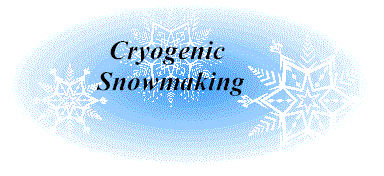|
|
||
|
For years snowmaking companies have tried to produce snow at higher and higher temps. Most have failed but some have succeeded. Over the years people have used giant freezer systems to make snow, Liquid Nitrogen and Carbon Dioxide Dry Ice to name a few. |
||
|
The process Snowtech uses involves the creation of an environment, within a canopy, conducive to snowmaking by injecting a stream of Liquid CO² through an experimental snowgun. This creates an environment with an ambient temperature of around (dry bulb) -40º Celsius The snowgun used created a uniformly atomised spray of water droplets at about 100 micron which is basically a pure wet fog. These droplets freeze upon discharge from the gun head due to the extremely cold temperature of the environment within the canopy.
|
A SNOWTECH CRYOJET © SNOWGUN |
|
|
A SNOWTECH CMD II D © SNOWGUN |
Snow
has successfully been produced both indoors & outdoors in ambient
temperatures up to (dry bulb) +40º Celsius. Unfortunately
cryogenic snowmaking, regardless of the type process, type of equipment
or fluid used is an extremely costly process, due to the amount of
cryogen required to convert water to snow. An average conventional snowmaking system that produces snow at temperatures below a wet bulb temperature of -2º Celsius would produce snow at a cost of no more than $5.00 per cubic meter.
The cheapest that cryogenic snow could be produced commercially, while dependent on the cost of the cryogen would be no less that $100 per cubic meter.
Obviously this is has proved a non viable snowmaking option for ski resorts at this stage. |
|



